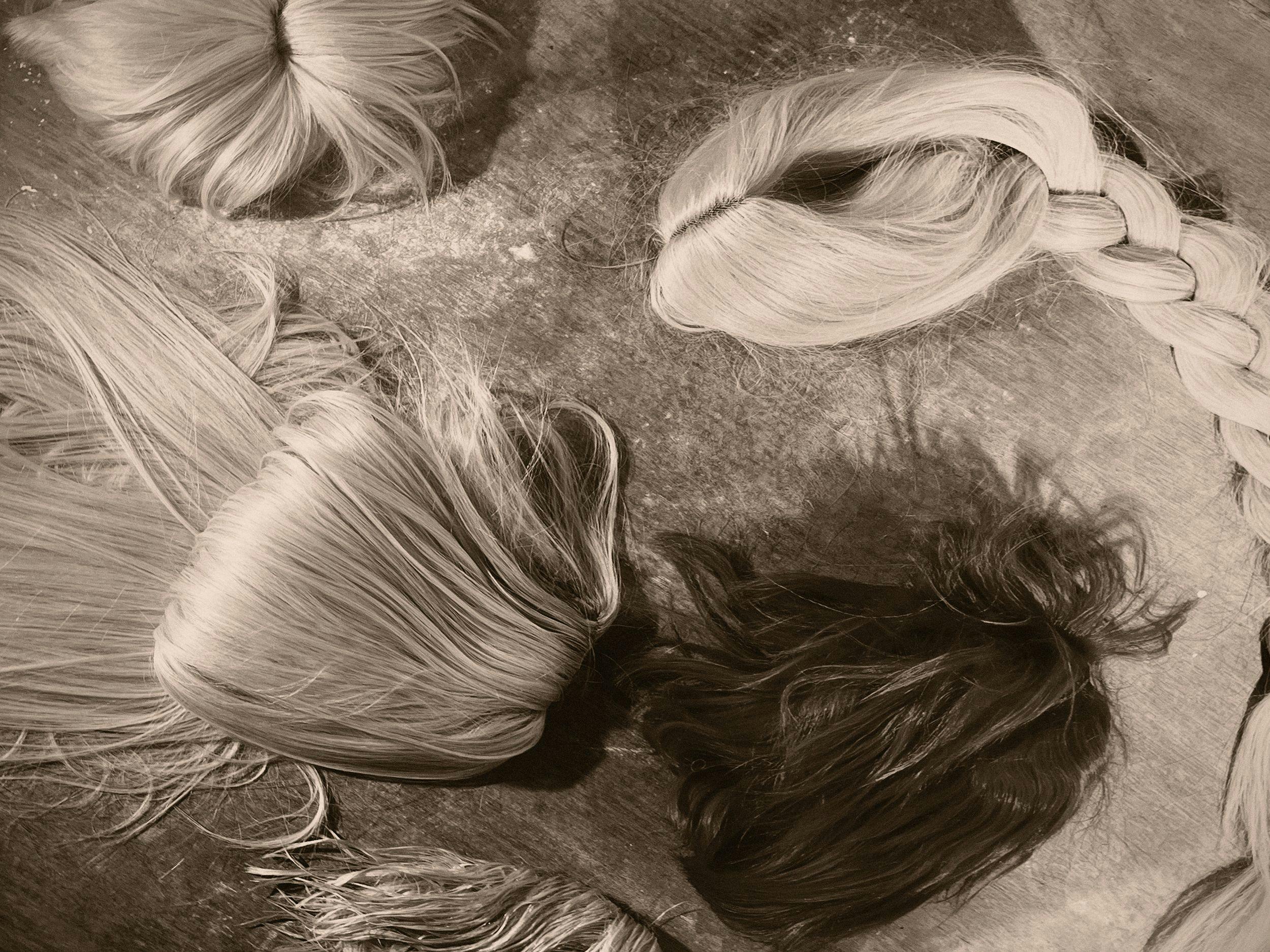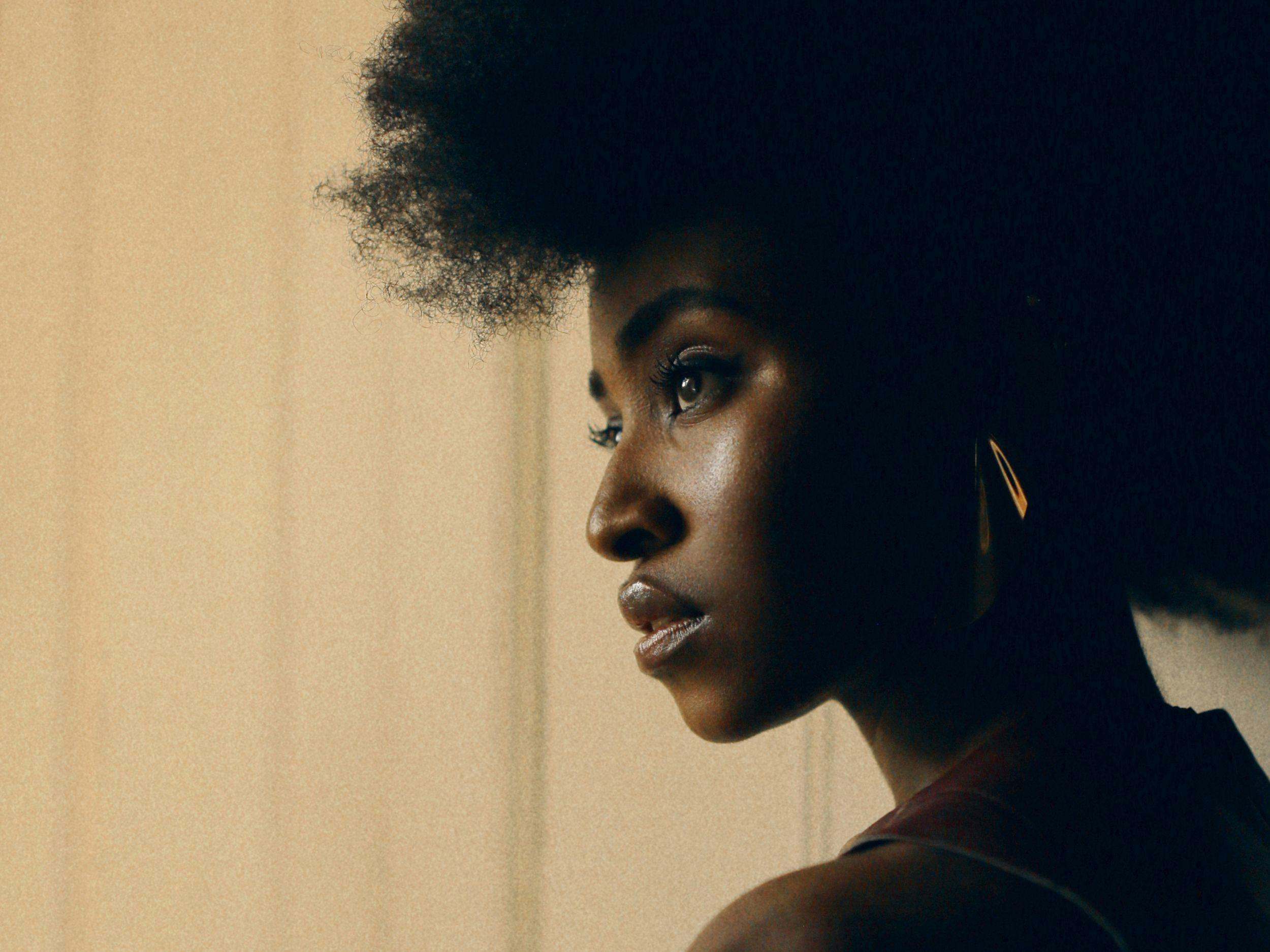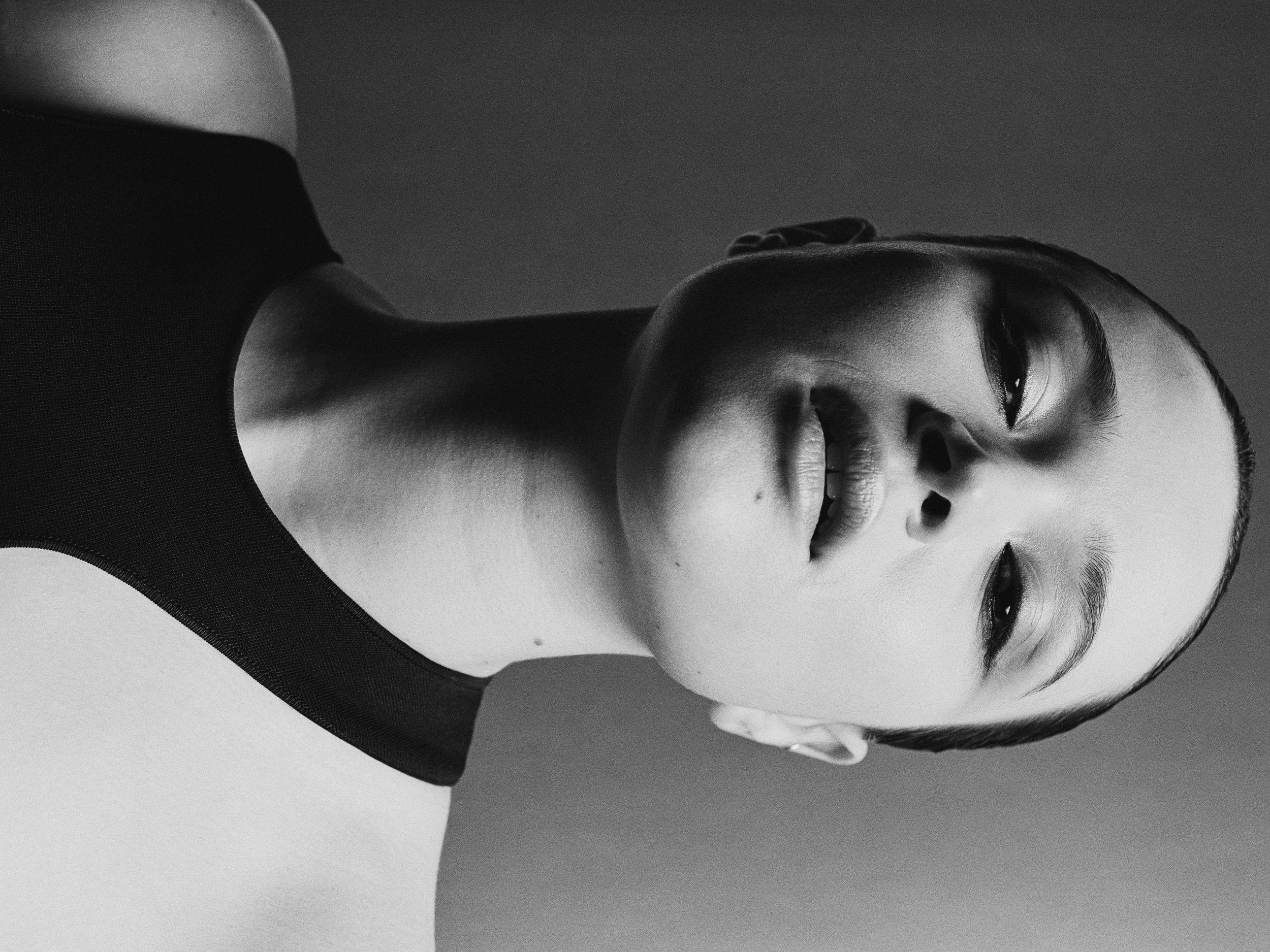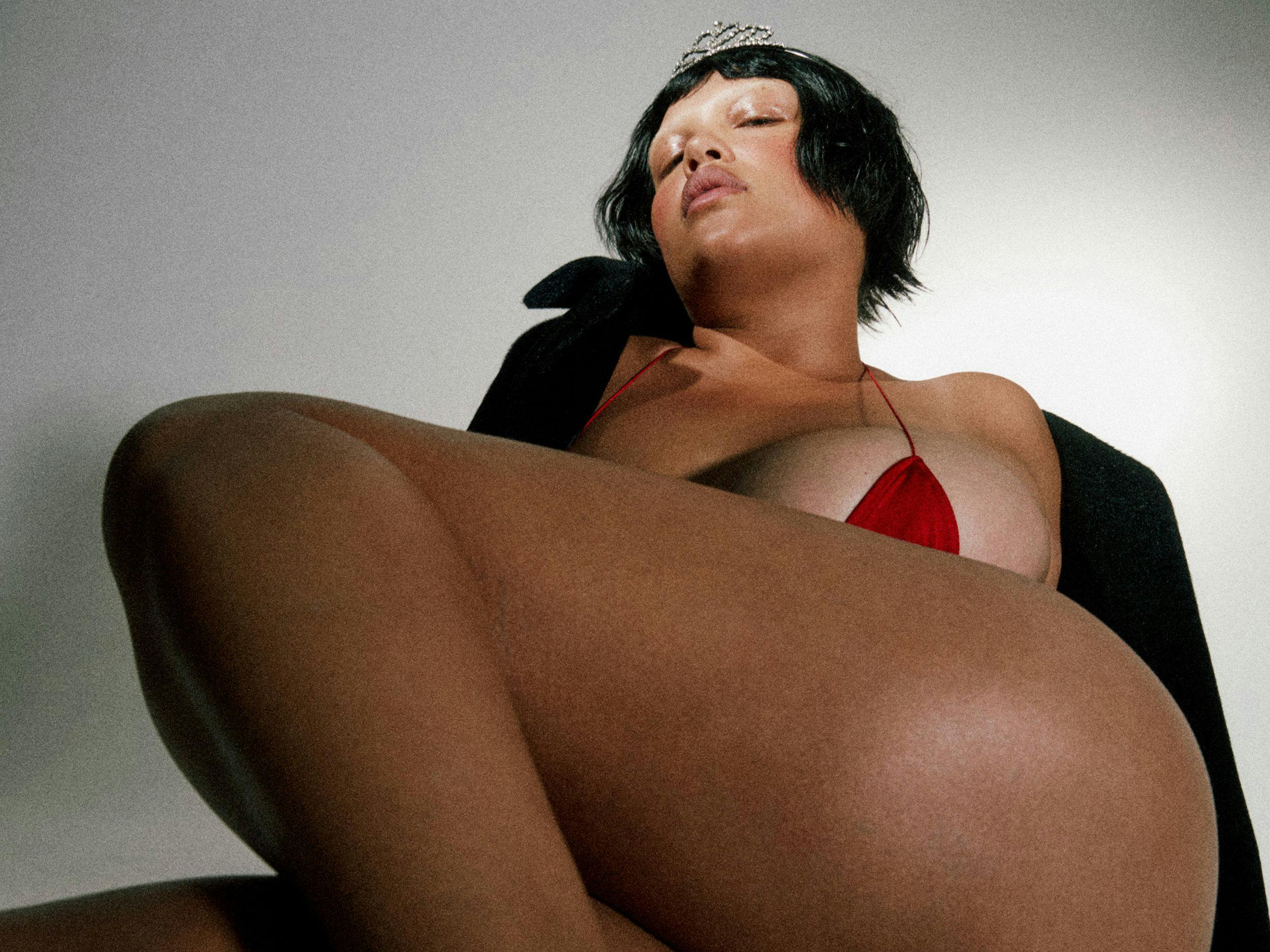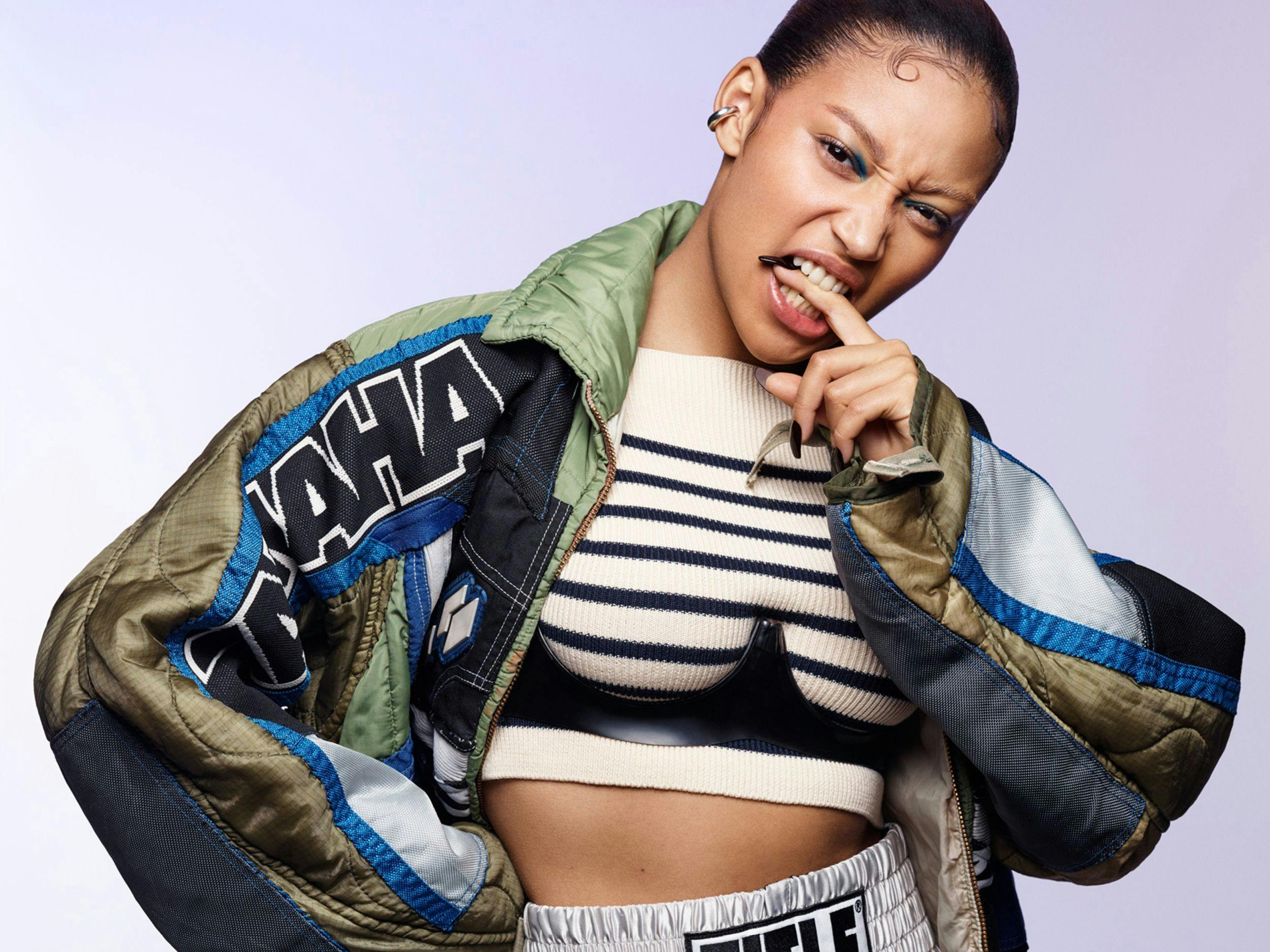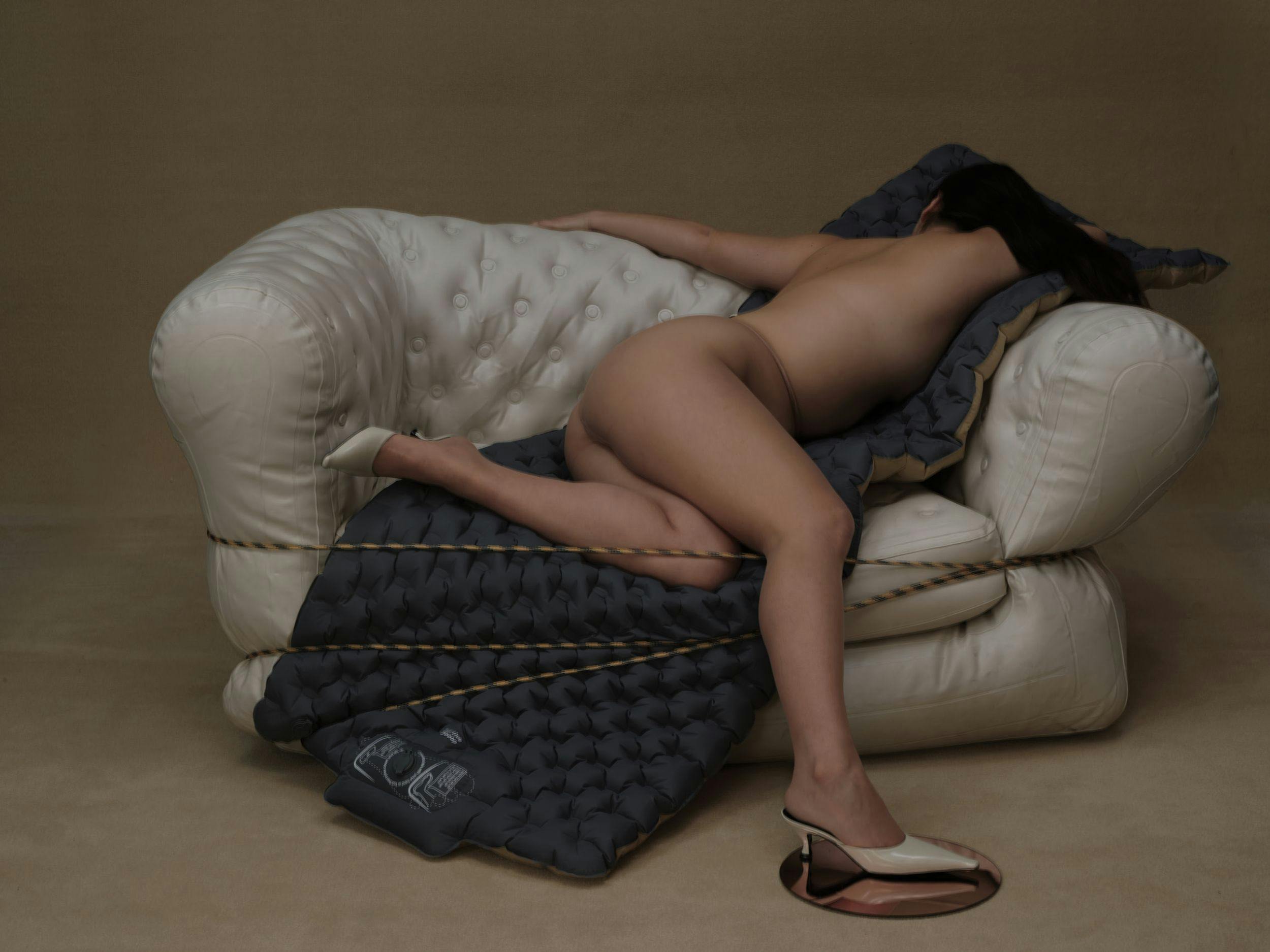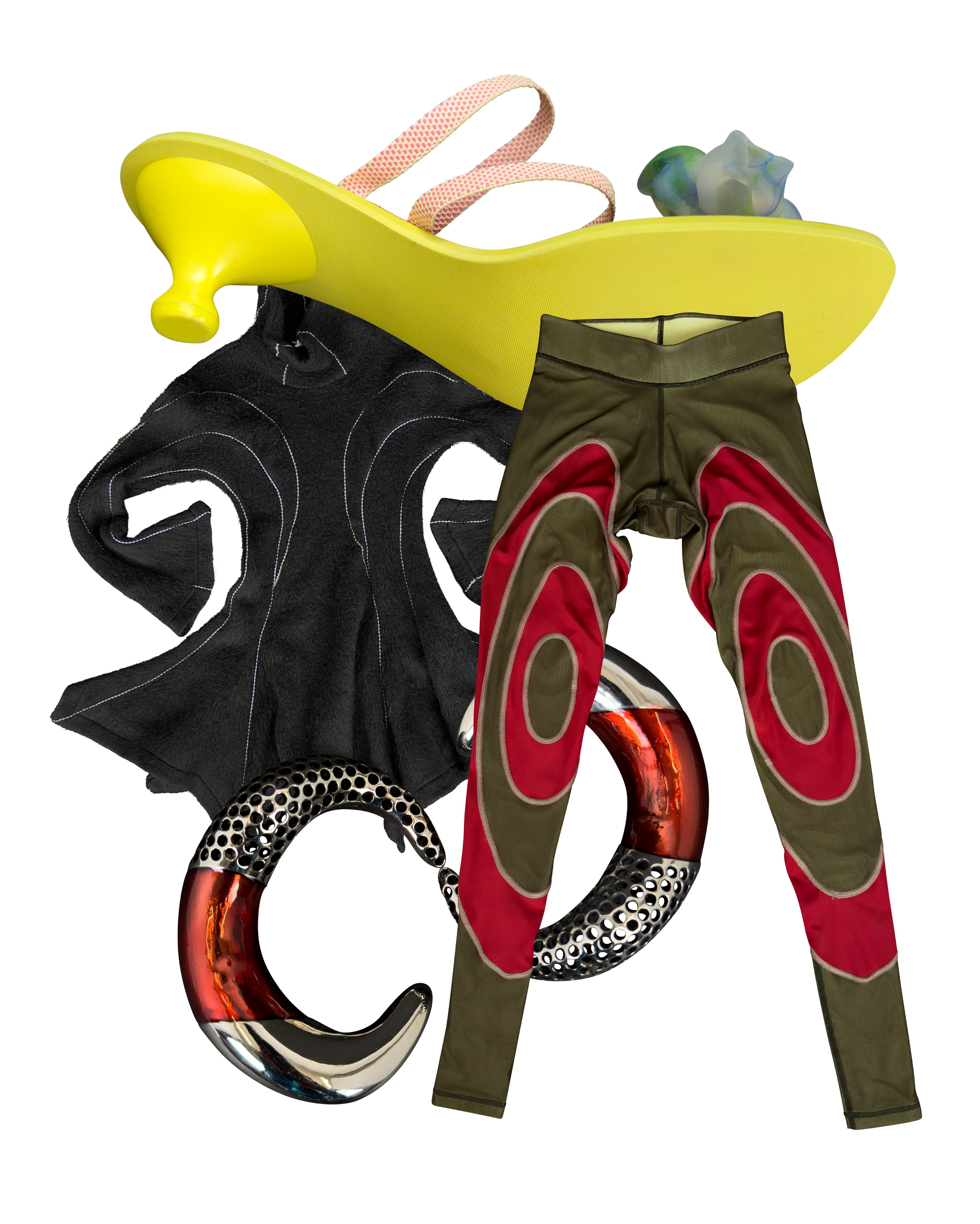
FROM TOP: Kiko Kostadinov x CAMPERLAB SANDALS, Spring ’20; DUSK DRESS, Fall ’24; Kiko Kostadinov x Asics LEGGINGS, Fall ’20; LIEBER CUFF, Spring ’25
Laura and Deanna Fanning in Conversation with Nymphet Alumni
Since stepping in as the creative directors of Kiko Kostadinov’s womenswear range in 2018, Laura and Deanna Fanning have built a reputation for subversion. Their collections often feel like puzzles, where history, pragmatism, and playfulness collide to create their signature fairytale futurism. Not content with æsthetics alone, the Melbourne-born twins excel in storytelling, weaving characteristically surreal and historically inspired narratives into their silhouettes. Their designs evoke a sense of movement—through time, space, and identity—that feels both deeply personal and universally relatable.
In conversation with Biz Sherbert, Sam Cummins, and Alexi Alario of the Nymphet Alumni podcast, the Fanning sisters discuss the delicate balance between femininity and functionality and embracing an exploratory approach to design that resonates with a more introspective audience.

INFINITY CUFFS, Fall ’21
Biz Sherbert: Something you explore frequently in your work is girlhood, girliness, and femininity, but you also explore utilitarianism and techwear. That’s something that’s traditionally coded as masculine, so how do you see the relationship between those two things in your work?
Deanna Fanning: For me, girlhood is a little undefined, so it allows you to look at other things which maybe are traditionally more masculine. There’s not a set of rules that you specifically need to follow, so it gives you an element of freedom. Girls, teenagers, and young women go through lots of phases that aren’t necessarily just trend-based but are phases for themselves when coming of age and finding out what works best for them.
Laura Fanning: When you’re really young, you naturally put on things that feel awkward or that aren’t going to work. Something very beautiful can come from that, and I think that’s something that can be very modern at the same time. In that way, it can push how women dress in the future. It’s so odd because things like an A-line skirt or a bodice are so deeply coded in really antique wares, but they keep coming back in time. So, how do we look at those and shift them into what people feel comfortable wearing today? How can different types of femininity exist? We try to do that with our work.
BS: I’m also curious, coming off the ‘Year of the Girl,’ as it’s been proclaimed in media and fashion, where does your relationship to that stand? Is it still something that really interests you in your work, or do you have any kind of thoughts on this larger cultural phenomenon and what it’s become?
LF: I feel like in a way it can always be omnipresent. Even when you look at some women in their eighties, the way that they experiment with color or silhouette can be very playful, very naïve, and sometimes childish. For us, it’s something that will always be current in what we do.
DF: I suppose we’ll always find different ways to inquire about girlhood, which maybe isn’t so generalized. There’s a lot of tropes at the moment in fashion, but I think it’ll always be there. At times, we’ll probably look at things which aren’t so palatable—to the detriment of our sales—but it will definitely still be there because it’s a reason why we’re doing fashion. We do like making and enjoy craft, but what’s always interested us is thinking about why we’re interested in certain images, a certain girl, the different nuances, and girl groups. There’s a mystique and an intrigue to some people and not others, an obsession with trying to manufacture that woman, but on the flip side of that is someone that just completely fails.
LF: I think they’re both really just as interesting. Clothes that are coded to be techy or masculine and clothes that can be very stereotypically feminine or girly, putting them together in a certain way highlights both of those women.

RIBBON BOOTS, special release 2024
BS: We were thinking about ‘blokette’ earlier, and it’s funny because it’s captured by the essence of a girl but by definition it combines masculine and feminine elements. That is maybe inherently part of what a girl is. Speaking of women and girls, with our podcast, we hivemind a lot, the three of us work really closely together. It’s really cool that you’re twins. What is working together like?
DF: Oh, unfortunately for the rest of our team, there’s this point in the season where Laura and I are talking about every single idea and we have moments. I call it a dialogue, but maybe people from the outside would think it’s bickering. I think it’s how good ideas come about, because then you can get to the crux of why you’re doing something or how you need to push something. Once we’ve processed everything together, then we give our thoughts over to the team in our direction. It’s always about collecting a lot of imagery, looking at a lot of garments, deciding which ones work, and editing.
LF: Also, in terms of a team, knowing which people will be able to execute different portions of your idea. Everyone in the team, they’re all very different designers, but all of their points of view are so valued. They really all bring so much to constructing who that person is seasonally.
BS: Do you find that one of you takes a certain role in your creative process or is it pretty undefined in that way?
DF: Maybe when we started? I have a knitwear background and Laura has a wovens background, so when we started everything we divided based on skill. Now, as the seasons have developed we don’t do that as much. [To Laura] I feel like you’re really confident in knowing what looks good in knitwear and what doesn’t. I’ve gotten better at knowing how things are in wovens as well.
LF: [To Deanna] I think you take more risks than me. You’re better at putting things together. Maybe I’m a bit safer or focused on silhouette, but that just comes back to old training. Normally it’s a lot of images that we start with and we have private conversations. I don’t know what the team thinks because we’re in an open office. We’ll go for a walk for an hour just to talk about things and then come back and it kind of moves like that. Midpoint in the season, we’re like, “Alright, how are we feeling about it?” We do the same process, but I feel the ideas move in three week blocks.
DF: Yeah, that’s true. You’re better at knowing what will work and what won’t. Nine times out of ten, you’re like, “Oh, that’s not going to work,” and it doesn’t. But I’m like, “Let’s try it, let’s try it!” Sometimes that’s not good because then the team will spend a week doing it and then it doesn’t work. You work on shoes.
LF: Yeah, but you do sometimes as well.
DF: Sometimes, but not as much as you.

OSEBERG SKIRT, Fall ’23
LF: It’s kind of strange because we’re still so small and we really value the craft of making clothes and what it takes for each piece. We have a few designers that work on the clothes and knitwear and then no one on accessories. It’s just this weird shift in the studio where it’s like, “Are you interested in jewelry? Do you like shoes? Do you like bags?” We’re all clothes designers and I think people are interested in different things with accessories. People naturally gravitate towards accessories, but it’s not something that anyone is trained in.
Sam Cummins: I was really drawn to your ability to fasten things together, not just literally but very much spiritually. You’re synthesizing contrasting patterns, historical silhouettes, and fabric textures. Since you guys were speaking about your relationship, I wondered if the balancing of contrast was something that arose from the nature of working as a duo or is it just the way that you both think naturally? Do you feel that’s sort of a byproduct of working in a two-person team?
DF: I think it’s definitely part of being a two-person team.
LF: I think so. I don’t know if it’s Freudian, but when you’re a kid and you’re a twin—girl twins, maybe guy twins too—you’re always compared. “Oh, so she’s the girly one” or “she’s the boyish one.” Today that wouldn’t happen, it’s not PC. Growing up in the nineties, you’re always like, “Yes, she wears this, you wear that.” People are always pointing out what’s the same and what’s different, so you’re always being measured by those æsthetic or superficial differences. I don’t think people mean it to be cruel at all. It’s very offhanded comments to make you feel included in a way.
DF: I guess it’s the easiest thing for someone you don’t know very well to talk to you about when you’re a kid.
LF: Maybe that has left us thinking about visuals in terms of contrasts or dichotomies and how they can exist together.

TRIVIA BAG, Spring ’22
SC: I was really charmed by the ability to look over all of your collections over the past few weeks. Something that really struck me is your approach to the human body. We’ve spoken before in our podcast about the limitations of the unchanging form of the human body and how that presents some challenges to creating silhouettes because the body never changes. I wanted to know what you guys thought about the human body. What’s your relationship to the body? How does that inform how you innovate silhouettes?
DF: Most of the time, knitwear has a very soft element. It’s harder to make structure, so the body is so important to knitwear because it helps create the shape, but then woven garments create the shape over the body.
LF: When we started, the wovens were a reaction to what knitwear could do. It had a lot of tunneling and a lot of shaped elements. In a way, that was me trying to construct a body in a response to what Deanna was doing with the knitwear. Maybe that goes back to our graduate collection a long, long time ago. We had chainmail knitwear pieces and then other pieces in very suffocating elastomeric knitting that needed like twelve hours to knit on an industrial machine. It was really counterintuitive, and I would then further that, I’d cut it, shape it, and create shoulders and elbows.
DF: [To Laura] You were really fascinated with articulation.
LF: I think it’s a response to how overdone jersey is and how the perfect female body couldn’t be more relevant today. I was in Puglia on holiday only a week and a half ago and I was really fascinated because the women are absolutely beautiful, but your best accessory is your tan and your body. I was like, “Wow! What does this leave for clothes?”
DF: Growing up in Australia, people are quite harsh and quite specific on body types—or they were when we were growing up.
LF: Sport is at the forefront of what the culture is, arguably. If you can’t use your body in a way…
DF: That’s productive from a sportsmanship perspective…
LF: Then it’s a little bit undervalued.
DF: That’s what’s so good about clothes. It gives you a whole world to dream about that’s not just purely physical. You have control to make this other physique, a whole identity that’s not just skin deep.
SC: I love your relationship to sportswear. I was really intrigued you mentioned being a part of Australian culture, sports being at the center of that. You’re really able to balance functionality with pushing the boundaries of silhouettes and making something really decorative and creative.

APEX MOTIF DRESS, Fall ’20
Alexi Alario: You guys mentioned a fascination with It Girls or Anti-It Girls and the qualities that make people stand out or make them rejected by society. In our fashion history research, we’re often fascinated by the relationships between designers and their muses, whether they’re real or imaginary. I was wondering if you’ve ever done the classic boardroom exercise of imagining the archetypal Kiko girl. If so, what is she like to you? Did she get good grades in school? What’s her dream vacation? How does she celebrate her birthday? Questions like that.
DF: I remember when we started, that seemed to be what old journalists were concerned about.
AA: Oh my god, I’m sorry!
DF: No, no! Maybe older journalists could understand those things and relate to them. So that was really key. When you start working on a brand, the clientele’s really small because it takes time for people to hear about it, so we’d just be essentially talking about our friends. I think the age gap was so big because at the time we were in our twenties and some of our friends were still at university. Some of them had just gotten their first career-type job, some people were traveling. It was a very specific clientele. Having to explain who these girls were to some established journalists who were in their fifties or sixties, they were very lost. They couldn’t understand what the girl was like, where she went on holiday, what she did day to day. What’s nice now is that we have retrospect, we have done a lot more collections, and we can look back.
LF: It’s definitely cumulative. Being in a major city, you get to see the girls walk by on the street and that puts a real view as to who she is and where she may be. When you said it, I was in my mind doing an exquisite corpse of all of the girls I’ve seen on the street. That’s very literal, but it really did take some time. When you’re trying to create something…
DF: Or create a nature of perspective, it takes time defining this world…
LF: I think we’re still working on it.
DF: Because it’ll always change as we move throughout the collections.
LF: I just really hope I don’t ever have a disconnect like those journalists in their fifties or sixties.
AA: Where you can’t even imagine the type of person?
LF: Yeah, I hope that never happens. In more of the commercial sphere of our work, they talk about generations like Gen Alpha, Gen Z, and millennials.
DF: They do focus groups on it.
LF: Yeah, and they pull pictures. In that way you’re forced to know who they are.
DF: It must be so superficial looking at a powerpoint and being like, “OK, so this is Gen Z,” and it’s ten dot points with what they spend their money on and what they like. It’s always generic photos.

PETITE MEZULARI BAG, Fall ’24
LF: I’m really intrigued by legacy designers that are still designing and I wonder how in touch they are with the younger girls that really aspire to wear their brands or even buy the vintage pieces from their brands. I don’t think I’ve met too many. I have this phobia where I don’t want to meet anyone that I really admire in case it turns me off. That generation of sixty- to seventy-year-olds, I really fear it, because we love really great designers that have been able to have their own point of view over decades. That’s just a bit of a side note.
DF: Even those designers, when I was in my early twenties, Rick Owens was really peaking. I’m thirty-four, so that’s fourteen years ago. Perhaps once I got to my middle or late twenties, in the circles I was in, no one was really wearing Rick Owens. Now I think people are wearing it again.
LF: I would say a lot of people.
DF: Definitely, highly regarded people are wearing it. I would say it’s peaking again. It’s really interesting how that world or the type of person can change. With some of our corporate collaborators, they call it a life cycle.
LF: Yeah, we only learned that six months ago.
DF: Now we’re like, “Oh, this is a life cycle.” It makes it so ‘finance accountant’ talking about the life cycle of a bag or a shoe and it really detaches the humanity of it. Thinking about life cycles with people and how they view brands is kind of exciting because your immediate thought is…
LF: Do you think It Girls have a life cycle?
DF: Yeah, for sure.
LF: They can really be in fashion for five or ten years then dip and then another generation finds them and becomes obsessed with them.
DF: Reinterpretation of a life cycle as well, because why someone might have been drawn to something five years ago is not the same reason why someone is drawn to something in five years time, although they both may be highly regarded and successful.
AA: Rick Owens is a good example because Gen Z breathed new life into the brand because they were so interested in the mystery and the imagery. Especially with a lot of younger people, their relationship to that is more meaningful than the relationship to the actual clothes. It wouldn’t be that effective to show images in a boardroom to young people because I’m sure a lot of them will be like, “That’s totally my vibe,” but then it has nothing to do with how they actually spend money or how they actually dress. I think a lot of young people have a fantasy life, but it’s true the cycles are happening.
There’s a lot of buzz about your footwear designs which are really iconic and interesting, but while looking through a lot of your collections, I was fascinated by the other end, headwear. I especially love the use of fake hair in the Spring 2023 show in this book you sent us, which is really great. There was something really playful but also morbid about seeing these bits of hair alongside fabric scraps and trimmings in the photos behind the scenes. Unique hairstyling and headpieces have been a feature of quite a few collections including your most recent one, so I was just wondering where the headwear concept happens in the process. Does it come early on?
DF: Sometimes it does. I think it’s a key part of the look, especially from a runway perspective. I know it might be challenging to wear something like that on the street, but I really love that the runway gives you the opportunity to consider something like that. It won’t be to everyone’s liking.
LF: We know that a lot of people won’t like it.
DF: But you’ve got to have some kind of outlet where you can create the character.

CIRCLE WISHBONE BAG, Fall ’22
LF: I’m really intrigued with the way the top hairstylists are able to communicate ideas. I think being a fashion designer can be hard, but being that kind of creative is even harder because you have to think in a room with so many people. Sometimes designing can be really private, and I love hearing about how people’s studios run. Some people are very inclusive in the way that they design and others are very much on their own and pass things to freelancers or factories. There’s a real gap between letting people in and the product and the idea. I’m really fascinated with the way that hairstyling is directly building on the body. It can’t really be removed. I know some of those are wigs, but it’s a lot more rapid, a lot more intuitive, and there’s a lot less time to mull over anything. Beauty and hair is such an important part of the way that you can communicate ideas on a high fashion level.
DF: It was a marker of the time. I know that we don’t really use hairstyling and headwear from a trends perspective, but it is a real marker of where things are in terms of decades.
LF: Yeah, definitely. We’re really big fans of fashion history and fashion images, so I think that plays into being really interested in what those creatives can bring in a very extreme way or in a subtle way.
AA: It’s interesting that you said it helps in creating a character. The most recent show had these crown-like headpieces and ones with floppy ears on the sides, and I think there’s something really playful about imagining it from a fantastical perspective—what this character is doing.
DF: We ended up calling them wigs even though they’re not. The hair team was laughing because we called them wigs though they’re just knitted with silk yarn, but they did have to comb them. In China, if you wear a green hat, it means you’re cheating on your partner.
AA: I did know that. My Chinese teacher told me that, and she was like, “Never wear a green hat in China!” That’s the one thing I remember.
LF: Sometimes we tutor. One of the students was from Bahrain and she couldn’t do red shoes because red shoes in Bahrain are the most unlucky color of shoe to be wearing.
SC: I’m a very superstitious person and this is news to me. I’m going to throw away half of my shoes now.

INFINITY EARRINGS, Fall ’21
LF: It’s so funny when you think about all of the no-nos. One season—I think it was the second season—for me, it was the most hellish season ever.
DF: Oh, yeah.
LF: We both got whooping cough—four people in the studio got whooping cough—it was a really cold winter.
DF: It was a cacophony of coughs.
AA: That’s such an antiquated disease. I don’t know anyone who’s had that.
LF: We were all international from Australia or Japan.
DF: We didn’t have this British immune system.
LF: The germs were like, “Oh, fresh meat!” That season we decided to do purple in almost everything and this Italian buyer came in and said it was sporty-medieval. I was like, “Well, maybe that’s cool.” Then she said, “Purple? I can’t buy purple, it’s so unlucky.” It’s unlucky in Italy to wear purple.
AA: Someone should collect a list of all of these so emerging designers can know what not to do. It’s funny to find out that way.
LF: I still really like purple. I love purple.
DF: I still like it too. I’ll never forget it. It is the key color for me.
AA: That sounds like a crazy cursed season on top of the whooping cough. It’s a bad omen. I have another question about symbols. As far as shapes go, stars seem to be resonating with a lot of young people these days. There’s a whole æsthetic category called ‘Star Girl,’ which has been elevated to the status of being an identity in itself. Something like It Girl but also carrying the significance of nightlife and having a risky lifestyle. It’s a little bit like ‘rock star’s girlfriend.’ I spotted stars in a bunch of your pieces and I was wondering how that was introduced into the visual language of your collections.
LF: It was during Covid.
DF: Yeah, it was during Covid that we started doing this stuff.

DIANA BLOUSE, Spring ’23
LF: For us, it did feel like a very cliché way to interpret rebellion, freedom, and a way to feel like you could be out of the house. I think that was the second lockdown and it was really crazy. We had scaled our team really back. [To Deanna] It was three of us working on it, but you were doing it from Australia. We couldn’t even get fabrics from Italy.
DF: All the mills had shut.
LF: It started there. We really missed seeing symbols on the street that felt really throwaway, irrelevant, overdone, and overused. They have such baggage. It’s so odd that the star is a socialist symbol but is also very American. It’s so weird because socialism is all about the group and when you think about the stars in American cliché, you think of consumerism and individualism. It’s also on the Australian flag as well. We were thinking about those two ideas of socialism, consumerism, and how the star is there for both at the same time—that kind of duality.
AA: For me, it’s reminding me of how you were talking about being twins. People always need to find something to differentiate you against the other. Growing up, my sister was a heart girl and I was a star girl. She was always pink and I was purple. It was something that made you feel a little bit special in a way. It’s so funny to think about the political connotations. I didn’t even consider that, but they are on a lot of flags.
BS: Something we’ve been thinking about recently on the podcast is this new era of energy in British culture. You have Brat and Charli, Oasis getting back together, and maybe even Labour coming back into power to a certain extent, creating feelings that mirror what was happening in the nineties with Britpop, the Spice Girls, and British fashion. I’m curious about what defines British fashion to you? Do you feel any of that excitement or energy in London right now?
DF: Our studio is in Wood Green, we’re very tucked away, but Jake [Burt] and Stefan [Cooke] are just next door. We don’t necessarily have a community where we are. I don’t think it’s how it was—or how I imagine it was…
LF: In 2008 or 2009. I think all of the quite successful London designers were around that area right at that time and had studios there. In that way, I guess we’re a little bit separate.

HYBRID MARY JANE, Fall ’23
DF: Younger people are very interested in what’s going on locally though. I haven’t thought too much about it. It’s strange because our studio is in London, but I don’t think of myself as a British designer per se. Recently it’s been really tricky for local designers. I don’t think there’s been so much of a community, even people we did our masters with at Central Saint Martins who have started their own brands.
LF: A lot of them moved to Paris. We finished in 2018 and it takes two years to get something started, more or less. By the time it was 2020, everyone had moved. Now, the student intake has changed, so maybe that will spark a different kind of design. Maybe something that reflects a newness but also something from a time that was a bit more local.
DF: In terms of British design, I interned at Simone Rocha when I was a student and I interned at a brand called Roksanda. They were both women, so I thought that was quite inspiring. It seemed very logical work with the team. I never had that idea that I wouldn’t be able to do it, because I thought, “If these women can do it and they’re very presentable, front facing, and seem like nice people, then I can do that as well.” I don’t know if that necessarily relates to being part of a British trajectory per se.
LF: I know a lot of people have the romance when you start studying and the tutors are like, “Why are you here?”, some kids are like, “I like Alexander McQueen,” which I think people will say for a long time.
DF: Especially at CSM, the myths of McQueen and Galliano will never die.
LF: Rightly so, because of what they’ve done for fashion. I guess we didn’t really have that though. I did my undergraduate degree in Australia and those kinds of brands seem so far away. It was really hard to see what those designers were doing because there weren’t any boutiques to go to see the pieces, but there was a really big secondhand culture. I used to be able to buy vintage Comme des Garçons, Yohji, and Issey really easily. For me, I could feel the pieces, I could wear the pieces, and they seemed closer to me. I think it’s changed now.

FROM TOP: PINTORI SLASH TOP, Spring ’20; SONIA BROGUES, Spring ’23; TOPOGRAPHIC CARDIGAN, Spring ’20; PETITE MEZULARI BAG, Fall ’24
DF: London is such an expensive city. Whatever happened in the nineties or the early two thousands, I don’t think we can ever replicate, in terms of people having a studio where they don’t really pay much money for it.
LF: It seems like people come unstuck after three or four seasons.
DF: Being able to squat somewhere. I have one or two friends left that are in guardian schemes, but even that’s becoming a lot rarer.
LF: That’s true.
BS: My friends that are older than me and lived in Dalston in the two thousands would always talk about how they were the receptionist at a hair salon and they could afford designer bags because they were so much cheaper back then. They were paying like a hundred quid on rent. Things would really have to change for any of that energy to actually come back. So, can you guys tell us about your next collection?
DF: It has an element of…would you say aerospace?
BS: We did this episode about the revival of the sixties in the nineties in England—like Austin Powers. Alexi is really into aerospace.
AA: Yeah, like space age fashion. You guys should put a bid in for a spacesuit. I think Prada got the contract for doing the next spacesuits, but I would love a spacesuit by you two.
LF: It’s really funny because those ideas, they’re our parents’ generation, so in a way it’s odd for us to feel interested or connected to them. But you’re right, it’s because of the revival in the nineties of those ideas. They were really spoofy. We just got some first sample shares and were like, “These colors are disgusting!” I shouldn’t say that, but these colors are really, really difficult. I think they’ll be really good. I’m excited to see them on. We haven’t put them on yet.

ORPHEUS TIGHTS, Spring ’24
DF: [To Laura] I think why that was your immediate reaction was because it does look like a uniform in the way some of the colorways look. I think we’ll manage and I think it’ll be nice to have those moments.
LF: At one point we were like, “Oh no, are we just really overworked because we’re inspired by airplane uniforms?”
BS: Just at the airport all the time working.
LF: Maybe it was a year ago now, but because it’s so far away from where we are geographically, it was the first time I saw an Amish community travel. I was so fascinated by their headwear. They had this very constructed stiffened bonnet-type hat and it had an elaborate darting system in the back. It was like fifteen darts on this very crunchy white fabric.
DF: It was pristine.
LF: I was like, “Wow! How have I missed this? I’ve never seen this before.”
DF: It was such a contrast to what they were wearing, because they were wearing just cotton sundresses. Perhaps they were poly cotton because they were printed but very long—not shapeless—quite long to about the ankle, and had plain fleeces that zipped up with no hood. Oh, actually, I don’t know if they even zipped.
LF: Maybe they didn’t.
DF: I remember it looked like the fleecy side of a tracksuit. These headpieces looked so striking because of the multiples. Seeing everyone in a similar look in the airport was something new for us.
AA: We were talking a lot about aerospace in the Austin Powers episode because seeing things in airports feels so out of context no matter what. Often, these airports were built in a time where people were really optimistic about the future and there’s a nationalistic element of countries putting a lot of money into their airports and architectural innovation. It’s also kind of outdated at the same time. We love flight attendant uniforms.
LF: I can recommend a website. I don’t know if I have it on hand, but I can send it to you guys. This guy in the Netherlands collects airline uniforms and he’s archived maybe five hundred uniforms and puts them on the same mannequin. It’s very haunting.
AA: My dream guy.
LF: It’s super creepy, but some of them are really great. They span from the sixties to now. I have to send it to you guys.
AA: I would love to see that.

CUBIST PEARL BRACELET, Spring ’21
DF: I love the way you guys reference everything. I feel like my dream would be to send out show notes with links and have people make up their own minds from that. Then they would actually have to read something instead of getting a two-hundred-word roundup.
AA: You can do homework for before the show, required reading, and then you show up.
LF: I think we’d have two people at the show.
SC: It would be us. We would be the best.
BS: We would have reading for you to do as well.
SC: Yeah, like, “These are our thoughts.”
BS: I know you work with the utilitarian theme, which sometimes overlaps with uniform, but is it a continuation of anything recent?
DF: I don’t think we’ve looked at airline uniforms, that’s more new for us. At times I do feel that kind of ‘cringiness’ about it, that it’s something my parents would be interested in. We’ve done some prints based on old vintage stamps that are quite new for us. We haven’t really done prints before, so I’m a little bit nervous. We also are doing another Levi’s collab, which is going to be different to the one we just did. We’re doing two kinds of…I’m going to call them suits because I feel like that’s how we wanted them to be perceived. They’re definitely on the seventies side. One has an asymmetrical zip, a waisted belt, and it’s quite long and goes about to the hip. It definitely has a very sixties or seventies biker-type neck with pressed studs and some matching trousers that are flared. We’ve made it so that you can zip the flares, so you don’t have to have it open.
AA: That’s so cool.

PROMINA KNIT TOP, Spring ’25
LF: Sometimes I wonder why our work and what we’re fascinated with always goes back to something of a future. Do you think it’s because you’re always designing for the future, twelve months in advance, so naturally that will be what some of the work is about? I’m always like, “Should I push myself?” I have to push myself to read more things, look at more things, and see things in another way to do something different. I think it’s really hard—that tension, that monologue in your head because you want to do something new. But to survive, it has to be consumable.
SC: That’s always something that really strikes me every single time I see one of your collections, space specifically being situated within time. Your ability to capture a historical silhouette and seamlessly combine it with another is really fantastic and futuristic in a way that’s very unexpected.
AA: There’s a lot in fashion about nostalgia right now and that’s a lot of what the podcast is about. It’s unpacking those and contextualizing them. I feel like you guys managed to create something that’s just nostalgic enough but is also something that you haven’t really seen before. You’ve done a really good job at making things futuristic.
BS: Any final thoughts?
LF: I’m happy this isn’t the first thing that came up, but the way that we work is irregular to a lot of other designers because we’re designing for a brand that’s not our own, not a heritage brand. That can sometimes be a challenge to the people viewing the work, it can be a confusing way to perceive it. We’re really lucky that Kiko’s World is like a universe, but there’s worlds spiraling around each other. In that way, it’s quite nurturing. Maybe we’re in this bubble on the periphery, but it can be to our advantage.
AA: It’s a very aerospace metaphor.
SC: I like the references with postage stamps. Moving through time and space is very much something that you guys seem to be drawn to conceptually, even just transcendence. Postage stamps, I feel they exist or travel in the same way as airplanes do in my head. I don’t know why. It exists in the same plane of existence. It goes through a liminal tube and manifests in a country.
BS: So nice to chat with you. We’ve been big admirers of yours for years, and to actually hear you guys talk about what inspires you and what you’re working on has been really, really cool.
DF: I’m so happy that we got to chat with you all. Thank you so much. It’s really a dream because I am such a fan.
AA: It’s very mutual, super mutual.
SC: We love you guys.
Read this story and many more in print by ordering the special edition of CERO 9 here. Laura and Deanna have selected the Womens Earth Alliance, which invests in women leaders on the frontlines of the climate crisis to ensure social, economic, and environmental justice, as the recipient of proceeds from direct sales of CERO 9.

ELSPETH KNIT CAPRI, Spring ’21
As a nonprofit arts and culture publication dedicated to educating, inspiring, and uplifting creatives, Cero Magazine depends on your donations to create stories like these. Please support our work here.
